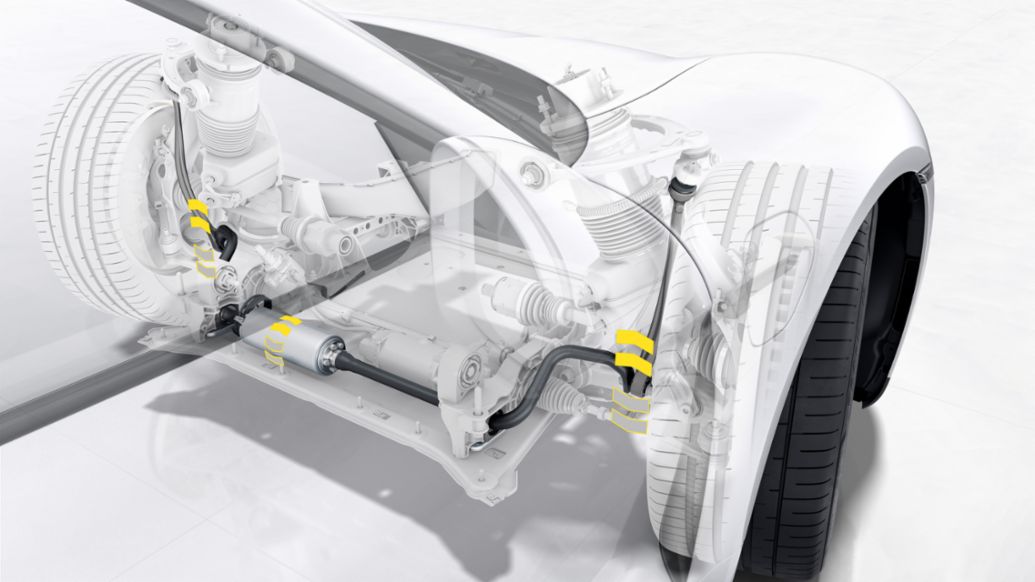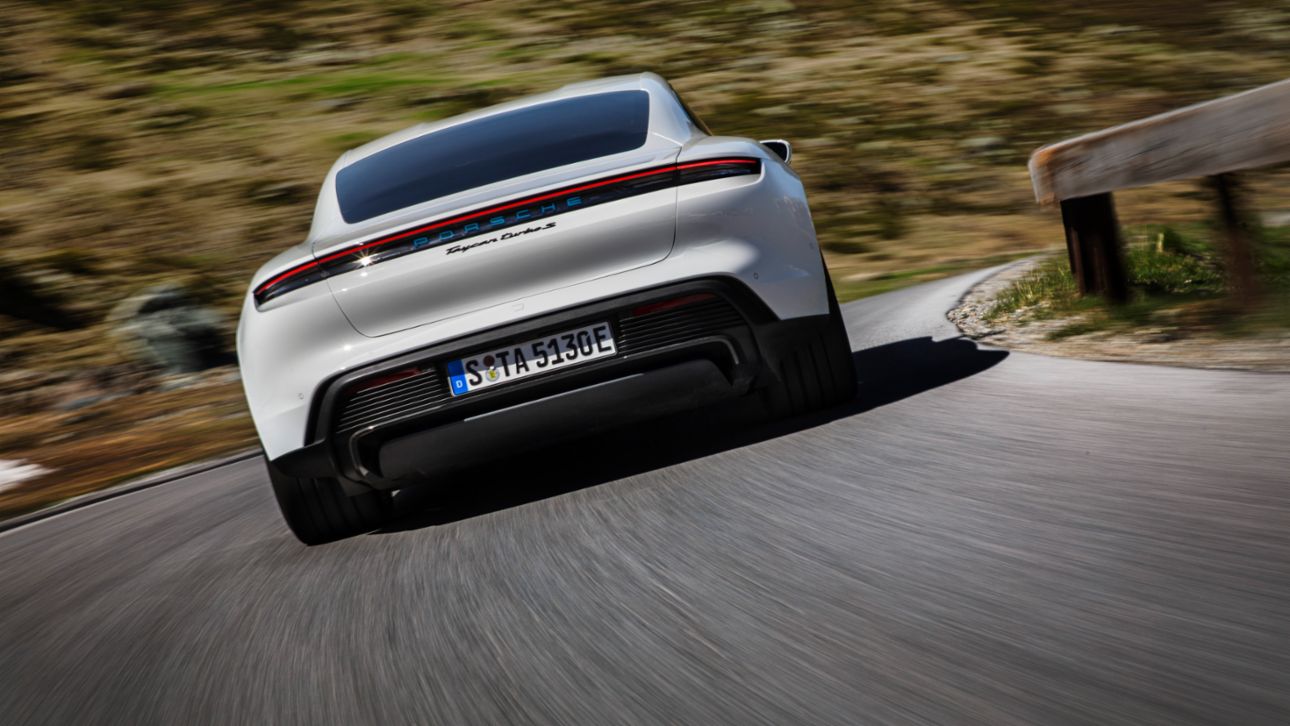The basic layout: at the front, Porsche uses a double-wishbone axle with forged aluminium wishbones and hollow-cast aluminium lightweight swivel bearings. On the rear axle, a multi-link axle with forged upper aluminium wishbones and hollow-cast lower aluminium wishbones performs wheel guidance.

Porsche 4D-Chassis Control: intelligent command centre
Porsche uses a centrally networked control system for the Taycan chassis. The 4D Chassis Control analyses the current driving situation in all three dimensions (longitudinal, lateral and vertical acceleration) and then calculates the vehicle status. It then shares this status with all the chassis systems in real time – adding a fourth dimension to chassis control. As a result, the systems provide an integrated response to the current driving situation.
PASM: real-time analysis and synchronisation
The Porsche Active Suspension Management (PASM) electronic shock absorber control system is included as a standard feature. The system responds to the road surface conditions and the current driving style, constantly adjusting damping for each individual wheel accordingly. Drivers can choose from four driving modes: Range, Normal, Sport and Sport Plus (for further details, see the Drive article).
So, how does PASM work? Sensors record the body movements generated during fast acceleration, braking, fast cornering or driving on uneven road surfaces. PASM sends the recorded data to the Porsche 4D Chassis Control. The command centre calculates the current vehicle status and regulates the damper characteristics and spring rates depending on the selected mode. Thanks to the three-chamber air suspension technology, different air suspension volumes can be switched within milliseconds. The 4D Chassis Control system also allows the control parameters of the other electronic suspension systems to be adjusted accordingly. The noticeable result: more driving stability, performance and comfort.
The Taycan uses a single-tube damper instead of a conventional twin-tube damper. This is not only lighter, but it also offers a better response and a greater balance between comfort and sportiness.
Adaptive air suspension: always at the right level
The Taycan's three-chamber air suspension provides a wide range of spring rates. This allows the chassis to be adjusted to a low basic spring rate and therefore made more comfortable. As soon as necessary, the spring rate is electronically adjusted in a fraction of a second - for example when accelerating and braking. Roll movements are reduced via volume control.
In addition, the air suspension offers the well-known advantages of ride height control. These include the fact that the vehicle height remains the same or at the desired level, regardless of the vehicle load. What is more, the frontal area can be reduced in two stages by lowering the front end, thus optimising the range. Three further levels are available in addition to the normal level, depending on the driving modes. In the Range and Sport Plus modes, the chassis is always in the lowest position (-22 millimetres):
-
The lift level raises the chassis by 20 millimetres to prevent the front spoiler from bottoming, for example when entering an underground car park. This level can be set at speeds up to 30 km/h.
-
From a speed of 90 km/h, the Taycan is lowered by ten millimetres.
-
And when 180 km/h is reached, the body is automatically lowered by a total of 22 millimetres to improve road holding and aerodynamics at high speeds.
PDCC Sport active roll stabilisation: quick to react and efficient
The active roll stabilisation system, Porsche Dynamic Chassis Control Sport (PDCC Sport), uses electromechanical anti-roll bars. When required, the system reacts in just 200 milliseconds in order to stiffen the anti-roll bars to prevent the body from rolling. This makes PDCC more than 30 per cent faster than similar systems using hydraulic actuators. A further advantage is the lower energy consumption of the system, which is particularly important for an electric vehicle and allows the electric range to be optimised.
Porsche Torque Vectoring Plus (PTV Plus): more agile self-steering
Porsche Torque Vectoring Plus (PTV Plus) uses an electronically controlled differential lock on the rear axle for variable distribution of the drive torque between the rear wheels. On the one hand, additional yaw torque can be generated on the rear axle by braking the inner wheel on the bend. This ensures that the vehicle's steering response is even more agile. On the other hand, it improves traction by specifically locking the differential when accelerating out of corners.
Rear axle steering: maximum steering precision and easier manoeuvring
Rear-axle steering is available as an option (standard in the Taycan Turbo S). This further increases comfort, driving safety and driving dynamics. The vehicle steers without delay and builds up lateral acceleration at the rear axle much sooner. The result is even more impressive steering precision.
At low speeds of up to about 50 km/h, the rear wheels steer in the opposite direction to the front wheels. The steering angle depends on the driving speed and is a maximum of 2.8 degrees. This virtual shortening of the wheelbase results in a more dynamic steering response when cornering. At the same time, manoeuvring is easier as the turning circle has been reduced by around 60 centimetres to 11.2 metres. In addition, with rear-axle steering, the Taycan automatically features Power Steering Plus with greater support for steering assistance at low speeds.
At speeds exceeding approximately 50 km/h, the rear wheels steer in the same direction as the front axle, again depending on the speed. The wheelbase is therefore virtually lengthened, thereby increasing stability, for example when changing lanes on the motorway.
The brakes: high-performance systems with ceramic materials
The Taycan Turbo is equipped with the high-performance Porsche Surface Coated Brake (PSCB) as standard. The brake discs are 415 millimetres and 365 millimetres in diameter (front/rear axle). The tungsten carbide layer applied to the grey cast iron discs increases braking performance and wear resistance. At the same time, there is a reduction in the amount of brake dust making the rims dirty. The PSCB is of particular interest for electric vehicles. This is because, depending on driving style, the conventional brake is used less frequently due to recuperation, the PSCB always results in shiny brake discs due to its high resistance to corrosion.
The top system is the Porsche Ceramic Composite Brake (PCCB) - standard for the Taycan Turbo S and optionally available for the Taycan Turbo. The lightweight ceramic composite brake discs are 420 and 410 millimetres in size respectively on the front and rear axles. The Turbo and Turbo S have ten-piston, aluminium monobloc fixed-caliper brakes at the front. The calipers are painted white (Turbo) or yellow (Turbo S).
Braking behaviour and braking sensation remain consistent thanks to the blended braking system – regardless of whether the battery is cold or warm, full or empty.
The wheels: two sizes, many designs
The wheel range comprises 20-inch (Taycan Turbo series) and 21-inch (Taycan Turbo S series) sizes. The summer tyres of the 20-inch wheels (front 245/45 R 20, rear 285/40 R 20) are range-optimised. The tyres of the 21-inch wheels (front 265/35 R 21, rear 305/30 R 21) are highly performance-oriented. All-season tyres are available for both wheel sizes, and winter tyres are available in the 20-inch dimensions. All the wheels have been aerodynamically optimised. In addition to numerous paint finishes, for example Aurum or Deep Black Metallic, Exclusive Design wheels with carbon aeroblades also provide options to customise the vehicle.
Additional content
Sports cars, redesigned with sustainability in mind. The first all-electric sports car, the Taycan, marks the beginning of a new era for Porsche as the company systematically expands its product range in the field of e-mobility. An overview.

